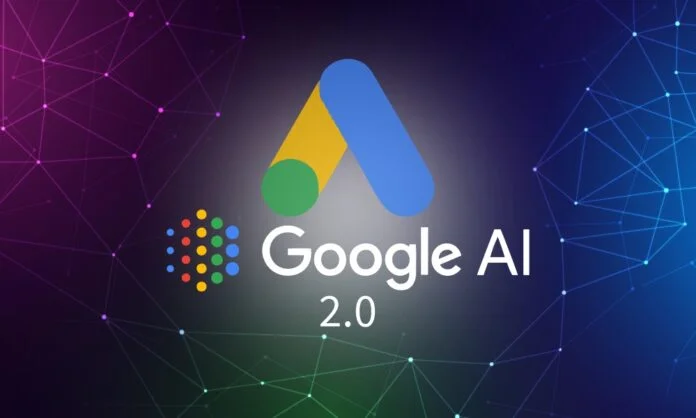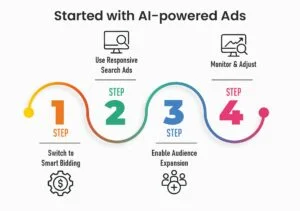Digital advertising has changed in the last few years, and Google Ads AI is leading this transformation. The latest version, Google Ads AI Essentials 2.0, brings powerful automation and intelligent optimization tools that help businesses run effective campaigns with less manual inputs.
This isn’t about replacing human marketers; it’s about giving them smarter tools to work with. The AI handles repetitive tasks and data analysis, freeing up time for strategy and creative work. The result? Better ad performance, improved ROI, and more conversions.
How Google Ads AI Essentials 2.0 Actually Works
At its core, Google’s AI reviews giant amounts of data to predict what will work best for your campaigns. It looks at factors like:
- When your ads work best
- Which audiences convert most frequently
- What ad copy receives the most engagement
- How competitors are operating their campaigns
The system automatically tracks your bids, targets, and ad placements to get maximum results. It’s like having a data scientist working on your campaigns 24/7.
Why Should Businesses Use Google Ads AI Essentials 2.0?
Here’s why AI-driven advertising is becoming popular:
Saves Time: No more manual bid adjustments or A/B testing for every ad variation.
Improves Accuracy: AI reduces human errors in targeting and budgeting.
Boosts ROI: By focusing on high-converting audiences, you spend less on wasted clicks.
Scale Campaigns Faster: AI handles large datasets effortlessly. It helps us to expand into new markets.
Key Features That Make a Difference
One of the most practical features is Smart Bidding. Rather than estimate how much to bid for clicks, the AAI automatically sets bids in real-time based on each user’s chances of converting. That way, you don’t pay too much for clicks that likely won’t result in sales.
Responsive Search Ads are another innovation. You input several headlines and descriptions, and the AI experiments with combinations to determine what best responds to different search queries. It learns over time which messages work for different audiences.
Getting Started with AI-powered Ads
Transitioning to AI-driven campaigns doesn’t have to be complicated. Start by enabling automated bidding in one of your existing campaigns. Choose a strategy that matches your goal, whether that’s getting more conversions, increasing website visits, or improving return on ad spend.
Allow the system a minimum of 2-3 weeks to build up sufficient data prior to passing judgment on performance. The AI requires time to understand what functions for your particular business. Throughout this phase, resist the urge to make manual adjustments. Let the technology do its wok.
Here is a step-by-step procedure on how to get started with Google Ads AI Essentials 2.0
Step1: Switch to Smart Bidding
- Go to your Google Ads dashboard.
- Under “Campaigns,” select “Settings.”
- Choose Maximize Conversions or Target ROAS based on your goal.
Step 2: Use Responsive Search Ads
- Create at least 3-5 headlines and 2-3 descriptions.
- Let Google test combinations for a few weeks before optimizing further.
Step 3: Enable Audience Expansion
- In your campaign settings, turn on “Optimized Targeting.”
- Google will find similar high-intent users beyond your initial audience.
Step 4: Monitor & Adjust
- Check the “Recommendations” tab weekly.
- Implement high-impact suggestions (like adding new keywords or adjusting bids).
Balancing Automation with Human Oversight
While optimizing is left to the AI, human intervention is still important. Review performance reports routinely to identify trends and opportunities. The AI offers suggestions, but check to see if they match your business goals prior to implementing them.
For example, if the AI suggests going after a new audience segment, ask yourself if those users really represent your customer profile. The technology is robust, but it can still use human input regarding your brand and objectives.
The Future of AI in Advertising
In the future, we can expect Google’s AI to become smarter. Future developments might include increased integration between search, display, and video campaigns as well as improved ability to predict customer behavior across devices.
Companies that learn to collaborate with these AI tools today will have a strong advantage. Google Ads AI Essentials 2.0 is bringing sophisticated advertising methods within reach of companies of all sizes, not only big-budget marketers.
Making It Work for Your Business
The key to success with Google Ads AI Essentials 2.0 is to start with clear goals. Keep the goal of making more awareness of your brand, sales, leads. Fuel the system with quality data using proper conversion tracking. And most of all, be patient while AI learns and refines.
Remember, AI is a tool, not a magic. The best result comes from combining the power of automation with human creativity and strategic thinking. When used properly, Google Ads AI Essentials 2.0 can help your business reach new customers and grow more efficiently than ever before.
For companies willing to move their advertising to the next level, it’s time to see what AI-based ads have to offer. The technology exists, it has worked, and it just keeps improving. The early adopters will gain the most as digital marketing continues to advance.
To learn about the latest trends, explore YourTechDiet!
FAQ
1. What are Google AI essentials?
Answer: Google AI essentials teach practical AI skills for everyday tasks, like using AI tools for writing, data analysis, and problem-solving.
2. How to use Google AI?
Answer: Use tools like Gemini via apps or workspace: ask for help drafting emails, analyzing spreadsheets, or other tasks.
Recommended For You:
DV360 vs Google Ads: Key Differences Every Marketer Should Know


